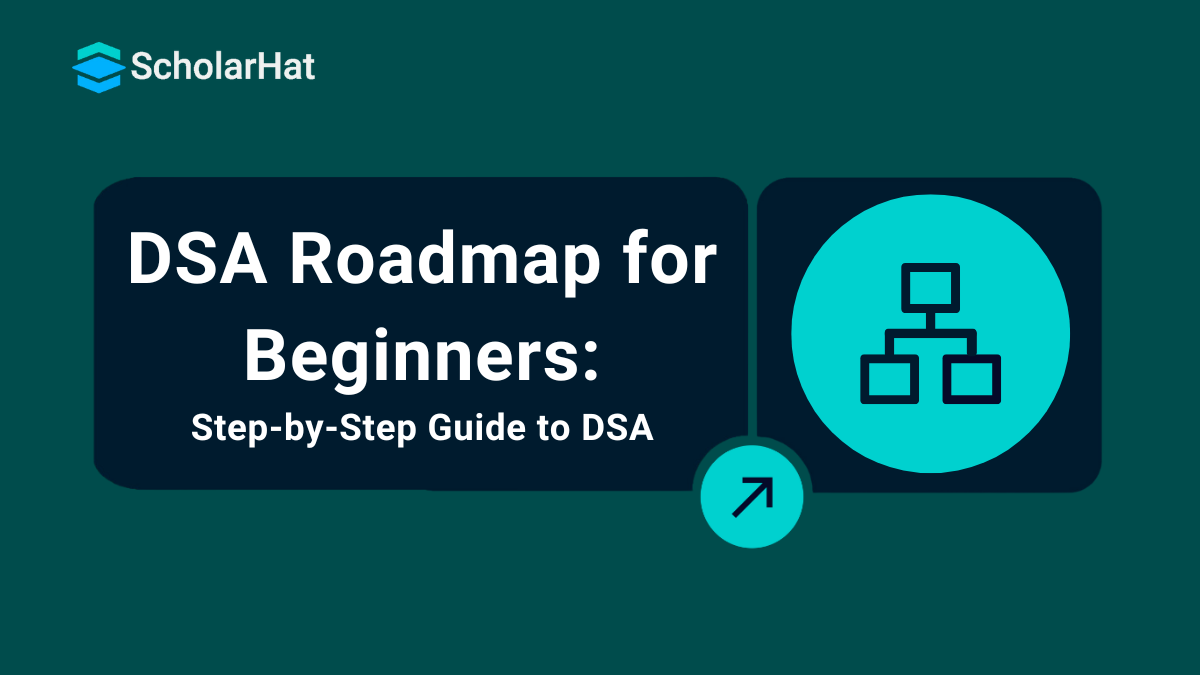DSA Roadmap for Beginners: Step-by-Step Guide to Master in DSA
DSA (Data Structures and Algorithms) is the foundation of efficient programming. It helps you organize data and solve problems faster using the right techniques. People learn DSA to improve their coding skills, clear technical interviews, and build better software. It’s important because it teaches logical thinking, problem-solving, and helps write optimized code for real-world applications.
This comprehensive DSA roadmap for beginners is your one-stop guide to mastering these fundamental concepts, equipping you with the problem-solving skills and algorithmic thinking sought by top tech companies. 90% of coding interviews focus on DSA – Get ahead with our Free DSA Course, earn a career-boosting certificate.
In this DSA tutorial, let's learn about the complete DSA Roadmap.

What is a Data Structure?
Data Structures store and organize data in the computer memory. It is the branch of Computer Science that deals with arranging such large datasets in such a manner that they can be accessed and modified as per the requirements. In other words, a data structure is a fundamental building block for all critical operations on the data.
What is an Algorithm?
An algorithm is defined as a set of rules or a step-by-step procedure executed in a specific order to get the desired output of a particular problem. In computer language, it is a finite set of instructions carried out at a specific time for specific problem-solving operations. We can say that it is not the complete program or code; it is just the logic of a problem. Algorithms can be represented as an informal description using a Flowchart or Pseudocode.
Read More - Best Data Structure Interview Questions and Answers
DSA Complete Road Map for Placement: Learn DSA From Scratch
Step 1: Pick the Best Programming Language for DSA
Learning a programming language of your choice is the basic step to understanding the concepts of DSA. By mastering a programming language, you will not only be able to demonstrate your technical skills but also showcase your problem-solving abilities. You just need to choose a language that you are comfortable with and that is widely used in the industry, such as Java, Python, or C++.
After choosing your preferred language, it is essential to practice coding exercises and solve DSA problems. To help you get started with the language of your choice, we have created free tutorials and self-paced complete courses to start as a beginner, such as:
- C For Beginners and C Programming Course
- C++ For Beginners and C++ Programming Course
- Java Tutorial For Beginners and Java Programming Course
- Python Tutorial For Beginners
Step 2: Build a Strong Foundation in Programming
1. Programming Basics for DSA
You need to have a clear-cut understanding of the building blocks of a programming language. They remain the same for all the languages. The following are the topics:
- Variables: Variables in C, Variables in C++, Variables in Java, Variables in Python
- Data Types: Data Types in C, Data Types in C++, Data Types in Java, Data Types in Python
- Operators: Operators in C, Operators in C++, Operators in Java, Operators in Python
- Basic Input/Output
- Functions: Functions in C, Functions in C++, Functions in Python,
- Conditional Statements: Conditional Statements in C, Conditional Statements in C++, Conditional Statements in Java, Decision-Making Statements in Python
- Loop Control: Loops in C, Loops in C++, Looping Statements in Java, Loops in Python
- Arrays: Arrays in C, Arrays in C++, Java Arrays
2. Understanding Time and Space Complexity
The primary aim behind using DSA is to solve a problem effectively and efficiently. How can you decide if a program written by you is efficient or not? This is measured by complexity. Complexity is of two types:
- Time Complexity: It is used to measure the amount of time required to execute the code.
- Space Complexity: It means the amount of space required to execute successfully the functionalities of the code.
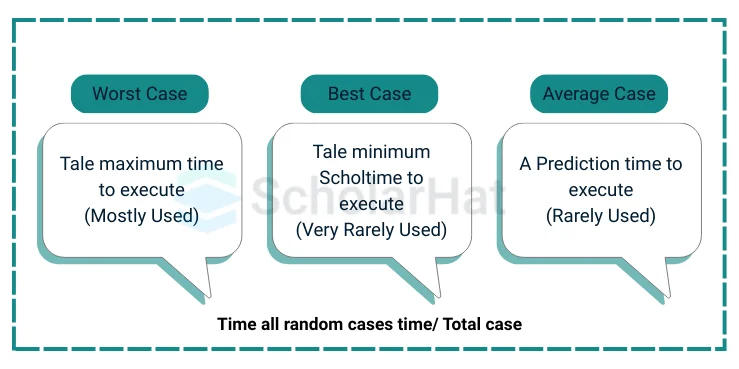
Read More: Complexity Analysis of Data Structures and Algorithms
Step 3: Master Key Data Structures
So, here is the crux of the article and the most awaited stage of the roadmap for learning data structures and algorithms. The topic of DSA consists of two parts:
Both are completely different but highly interrelated. Therefore, it is very important to follow the right track to learn them most efficiently. Understanding the time and space complexity of different operations on the various data structures is crucial for optimizing your solutions.
Let's look at the flow of learning a data structure and then the most related and important algorithms used by that data structure.
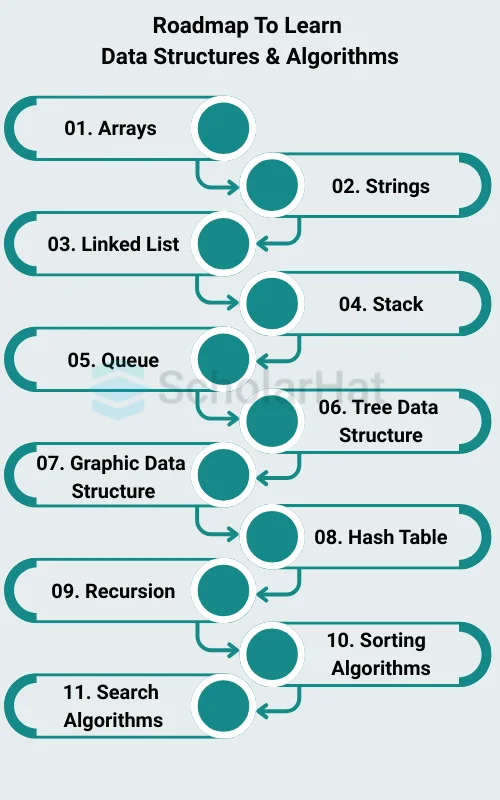
1. Arrays
An array data structure allows users to store and manipulate a collection of elements, all of the same data types in a single variable. Simply, it is a collection of elements of the same data type. The values get stored at contagious memory locations that can be accessed with their index number.
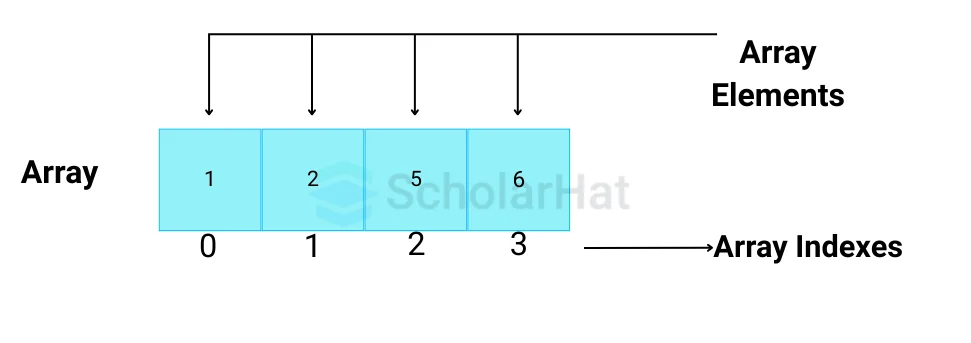
The various operations performed on arrays are:
- Traversal
- Insertion
- Deletion
- Search
- Update
Arrays have a wide range of applications, like:
- Storing and accessing data
- Sorting and searching data
- Implementing dynamic data structures
- Image processing
- Numerical computations
- Games and simulations
2. Strings
A string in C is a sequence of characters or an array of characters. e.g., "ScholarHat". Many programming languages, like Jav,a have a data type known as a string for storing string values. It is represented using double quotes ("") or single quotes (''). Whenever an array of characters e.g. c[10] gets created, the compiler implicitly appends '\0' at the end of the string.
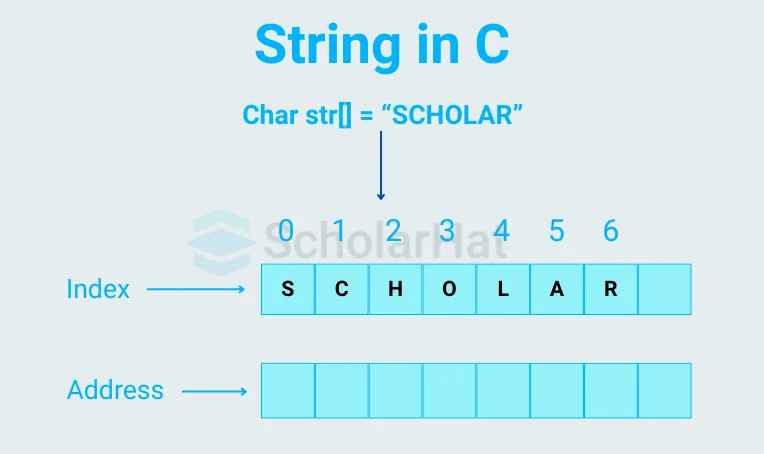
We can manipulate a string using various techniques like:
- Concatenation
- Splitting
- Replacing
- Trimming
- Searching
- Comparison
3. Linked Lists
In a linked list data structure, data elements are connected through a series of nodes using links or pointers. Each node contains two fields: the data field contains the actual data, and the pointer field consists of the address of the subsequent nodes in the list. The pointer of the last node of the linked list consists of a null pointer, as it points to nothing. The elements are stored dynamically in the linked list.

There are mainly three types of Linked Lists
- Singly-linked list: It is mainly used for the execution of stacks.
- Doubly linked list: It is used to execute heaps, stacks, binary trees, etc.
- Circular linked list: It is used to build circular buffers, organize many running applications, etc.
Learn linked lists in detail in the section Linked Lists in Data Structures
4. Stack
In the stack, elements are stored according to the LIFO i.e., Last In First Out principle. As per LIFO, the last element stored in a stack will be removed first. e.g., a pile of books. Stacks can be implemented with the help of contiguous memory, an Array, and non-contiguous memory, a Linked List.
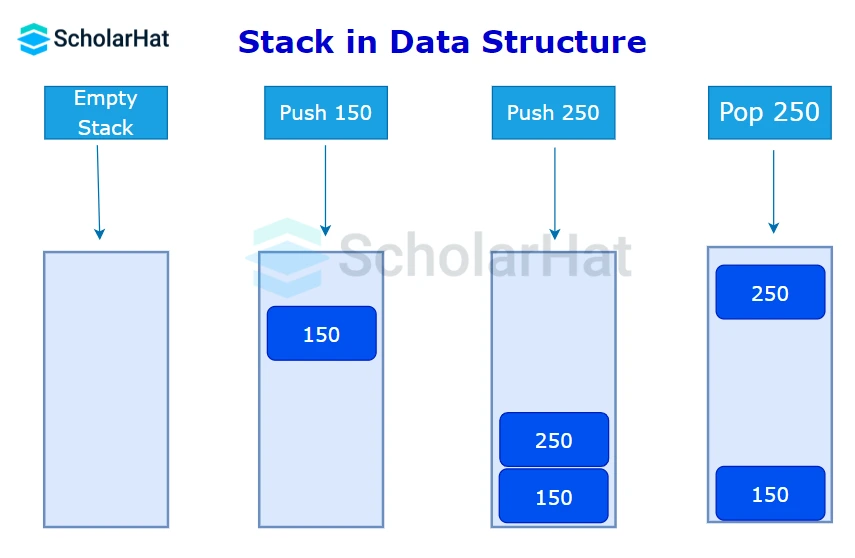
Standard Operations on Stack
- Insertion: push()
- Deletion: pop()
- peek()
- isFull()
- isEmpty()
Some of the major applications of stacks are:
- Recursion
- Expression Evaluation
- Parsing
- Undo/Redo Operations
- Backtracking
Learn stack and its implementation in detail in the section Implementing Stack in Data Structures
5. Queue
Here, the elements are stored according to the FIFO, i.e., First In First Out principle. As per FIFO, the first element stored in a queue will be removed first. e.g., students standing in a queue where the first student in the queue will enter first in the school first. The insertion of an element in a Queue is done at one end, and the removal is done at the opposite end. Queues can be implemented with the help of Arrays, linked lists, or stacks.

Standard Operations on Queue
- Insertion: enqueue()
- Deletion: dequeue()
- peek()
- isFull()
- isEmpty()
Some of the major applications of queues are:
- Job Scheduling
- Synchronization
- Operation on data structures
- Handling of interrupts
Learn queues in detail in the section Queue Implementation in Data Structures.
6. Tree Data Structure
It forms a hierarchy containing a collection of nodes such that each node of the tree stores a value and a list of references to other nodes (the "children"). It can be thought of as a linked list but with two or more pointers.
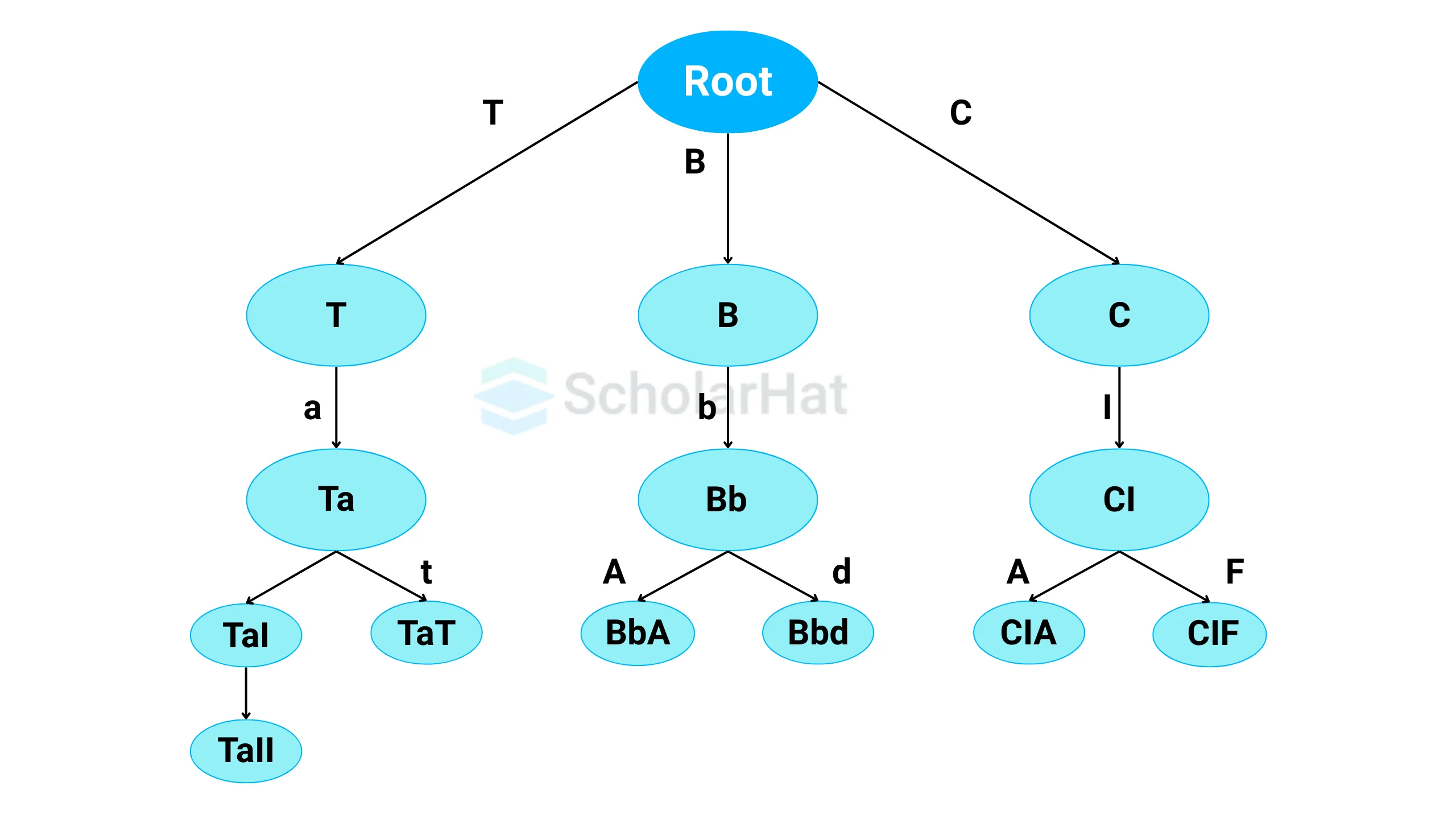
The following are the types of trees in data structures:
- Binary Trees
- Binary Search Tree
- AVL Tree
- Red Black Tree
Standard Operations on Trees:
- Traversal
- Insertion
- Deletion
- Search
Learn trees in detail in the section, Trees in Data Structures.
7. Graph Data Structure
Graph data structure consists finite number of nodes known as vertices and the edges connecting them. e.g. the nodes or vertices of a Graph can represent a single user in a telephone network, while the edges represent the link between them via telephone.

8. Hash Table
In this technique, we give an input called a key to the hash function. The function uses this key and generates the unique index corresponding to that value in the hash table. After that, it returns the value stored at that index, which is known as the hash value.
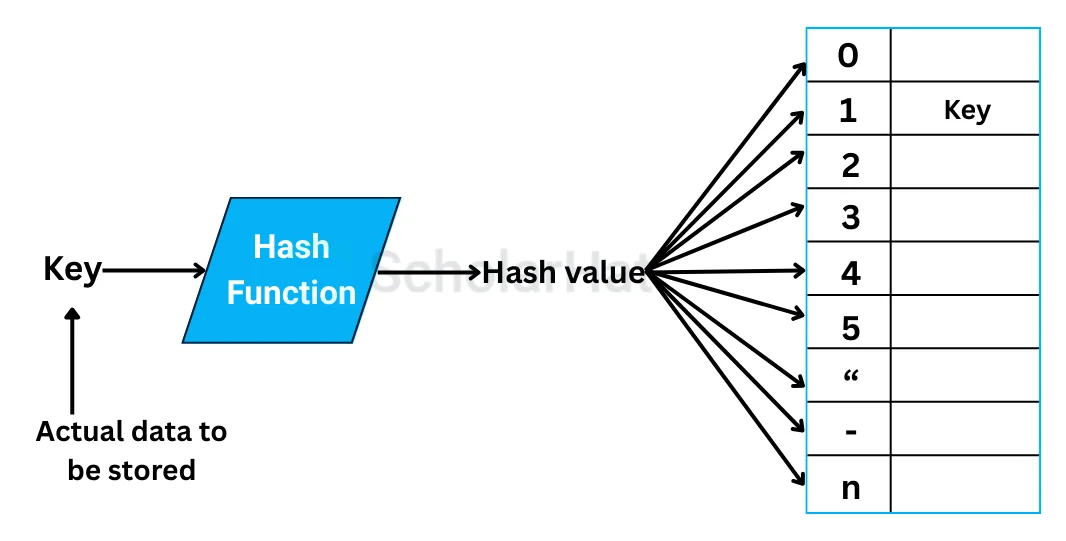
9. Recursion
It is a problem-solving technique in which a function calls itself, either directly or indirectly. In other words, when a function calls itself, it is known as recursion. The function that calls itself is called the recursive function.
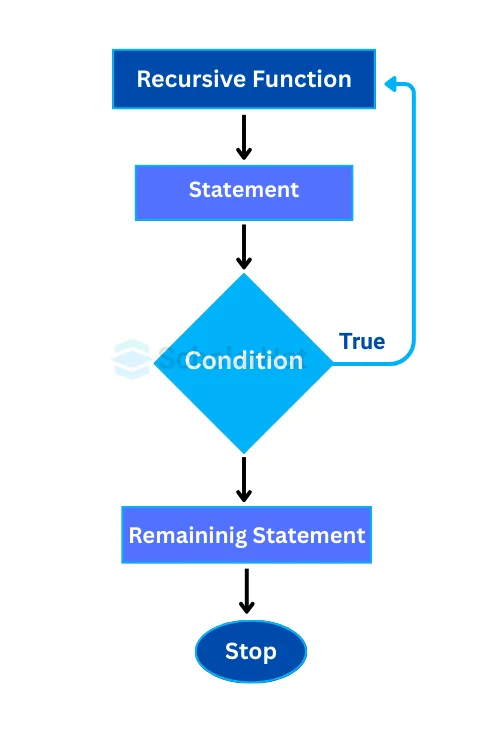
Learn the Recursion technique in detail in the section Recursion in Data Structures.
10. Sorting Algorithms
They are used to sort data in ascending or descending order. It is also used for arranging data in an efficient and useful manner. Some common problems that can be solved through the sorting Algorithm are Bubble sort, Insertion sort, Merge sort, Selection sort, and Quick sort.
Learn Sorting in detail in the section Sorting in Data Structures
11. Searching Algorithm
It is used for searching for a specific key in a particular sorted or unsorted data. Some common problems that can be solved through the Searching Algorithm are Binary Search and Linear Search.
Learn searching in detail in the section Searching in Data Structures
Top Algorithm Techniques: Divide and Conquer, Greedy, and Backtracking
1. Divide and Conquer: Break Problems Down
Definition: Divide and conquer is a powerful algorithmic technique for solving problems by breaking them down into smaller subproblems, solving each subproblem individually, and combining their solutions to form the final result. This approach is used in many efficient algorithms.
Steps:
- Divide: Split the problem into smaller subproblems.
- Conquer: Recursively solve each subproblem.
- Combine: Combine the results to form the solution.
Example: Merge Sort
# Example of Merge Sort (Divide and Conquer)
def merge_sort(arr):
if len(arr) <= 1:
return arr
mid = len(arr) // 2
left_half = merge_sort(arr[:mid])
right_half = merge_sort(arr[mid:])
return merge(left_half, right_half)
def merge(left, right):
result = []
i = j = 0
while i < len(left) and j < len(right):
if left[i] < right[j]:
result.append(left[i])
i += 1
else:
result.append(right[j])
j += 1
result.extend(left[i:])
result.extend(right[j:])
return result
arr = [38, 27, 43, 3, 9, 82, 10]
print(merge_sort(arr)) # Outputs sorted array
Output
[3, 9, 10, 27, 38, 43, 82]
2. Greedy Algorithms: Optimal Solutions
Definition: The greedy methodology is an algorithmic approach that makes the locally optimal choice at each stage, with the hope of finding the global optimum.
Steps:
- Selection: Choose the best option available based on some criteria.
- Feasibility Check: Check if the choice is valid and satisfies the problem constraints.
- Repeat: Continue selecting options until a solution is reached.
Example: Activity Selection Problem
# Example of Greedy Algorithm (Activity Selection)
def activity_selection(start, finish, n):
selected_activities = []
i = 0
selected_activities.append(i)
for j in range(1, n):
if start[j] >= finish[i]:
selected_activities.append(j)
i = j
return selected_activities
start_times = [1, 3, 0, 5, 8, 5]
finish_times = [2, 4, 6, 7, 9, 9]
n = len(start_times)
print(activity_selection(start_times, finish_times, n)) # Outputs indices of selected activities
Output
[0, 1, 3, 4]
3. Backtracking: Solving Complex Problems
Definition: Backtracking is an algorithmic technique used to find all (or some) solutions to a problem, particularly those that require a sequence of decisions. It explores all possible options and backs up when an invalid solution is found.
Steps:
- Make a choice: Select an option from the available choices.
- Recursively explore: Move forward with the selected option.
- Check validity: If the solution doesn't work, backtrack and undo the choice.
- Repeat: Continue until all solutions are explored or a solution is found.
Example: Solving N-Queens Problem
# Example of Backtracking (Solving N-Queens)
def is_safe(board, row, col, n):
# Check this column on upper rows
for i in range(row):
if board[i][col] == 1:
return False
# Check upper left diagonal
for i, j in zip(range(row - 1, -1, -1), range(col - 1, -1, -1)):
if board[i][j] == 1:
return False
# Check upper right diagonal
for i, j in zip(range(row - 1, -1, -1), range(col + 1, n)):
if board[i][j] == 1:
return False
return True
def solve_nqueens(board, row, n):
if row >= n:
return True
for col in range(n):
if is_safe(board, row, col, n):
board[row][col] = 1
if solve_nqueens(board, row + 1, n):
return True
board[row][col] = 0 # Backtrack
return False
def print_board(board):
for row in board:
print(" ".join(str(cell) for cell in row))
n = 4
board = [[0 for _ in range(n)] for _ in range(n)]
if solve_nqueens(board, 0, n):
print_board(board)
else:
print("Solution does not exist")
Output
0 1 0 0
0 0 0 1
1 0 0 0
0 0 1 0Practice Makes Perfect: How to Excel in DSA
After you have learned all the concepts of data structures and algorithms, it's now time for a lot of practice. This may be seen as a separate step or an integrated part of the process of learning DSA. Because of its importance, we are discussing it as a separate step.
Compete to Master DSA: Tips to Become a Pro
After getting good hands-on practice, test out your skills and efficiency. For this, the best possible way is to compete with others. This will help you find out your position among others and also give you a hint on the areas you are lacking. You should regularly participate in coding contests on various platforms to improve your problem-solving speed. Also, some online challenges are held from time to time throughout a year, which also provide lots of prizes and opportunities.
Explore More Resources:
1. Roadmap
Summary
So, now I hope that you have got a complete vision regarding the journey of learning this building block of Computer Science. The only requirement here is dedication and consistency. There may come a time when you won't be able to understand many concepts. Just remain patient and try to understand calmly.
Only 2% of Java Developers become Solution Architects. Don’t get left behind—Enroll now in our Java Architect Certification and secure your career growth & 60% higher salary potential.
| Download this PDF Now - DSA Roadmap for Beginners PDF By ScholarHat |
FAQs
- Choose Your Programming Language
- Master the Fundamentals
- Dive into Data Structures
- Practice, Practice, and Practice more
- Compete and Become A Pro
Take our Datastructures skill challenge to evaluate yourself!

In less than 5 minutes, with our skill challenge, you can identify your knowledge gaps and strengths in a given skill.

